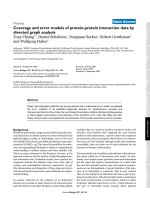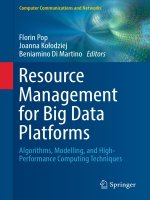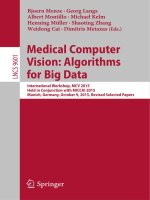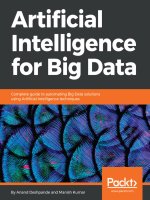Models of computation for big data
Bạn đang xem bản rút gọn của tài liệu. Xem và tải ngay bản đầy đủ của tài liệu tại đây (28.15 MB, 125 trang )
AdvancedInformationandKnowledgeProcessing
SpringerBriefsinAdvancedInformationandKnowledge
Processing
SeriesEditors
XindongWu
SchoolofComputingandInformatics,UniversityofLouisianaatLafayette,Lafayette,LA,USA
LakhmiJain
UniversityofCanberra,Adelaide,SA,Australia
SpringerBriefsinAdvancedInformationandKnowledgeProcessingpresentsconciseresearchin
thisexcitingfield.DesignedtocomplementSpringer’sAdvancedInformationandKnowledge
Processingseries,thisBriefsseriesprovidesresearcherswithaforumtopublishtheir
cutting-edgeresearchwhichisnotyetmatureenoughforabookintheAdvancedInformation
andKnowledgeProcessingseries,butwhichhasgrownbeyondthelevelofaworkshoppaper
orjournalarticle.
Typicaltopicsmayinclude,butarenotrestrictedto:
BigDataanalytics
BigKnowledge
Bioinformatics
Businessintelligence
Computersecurity
Dataminingandknowledgediscovery
Informationqualityandprivacy
Internetofthings
Knowledgemanagement
Knowledge-basedsoftwareengineering
Machineintelligence
Ontology
SemanticWeb
Smartenvironments
Softcomputing
Socialnetworks
SpringerBriefsarepublishedaspartofSpringer’seBookcollection,withmillionsofusers
worldwideandareavailableforindividualprintandelectronicpurchase.Briefsare
characterizedbyfast,globalelectronicdissemination,standardpublishingcontracts,easy-to-
usemanuscriptpreparationandformattingguidelinesandexpeditedproductionschedulesto
assistresearchersindistributingtheirresearchfastandefficiently.
Moreinformationaboutthisseriesathttp://www.springer.com/series/16024
RajendraAkerkar
ModelsofComputationforBigData
RajendraAkerkar
WesternNorwayResearchInstitute,Sogndal,Norway
ISSN1610-3947
e-ISSN2197-8441
AdvancedInformationandKnowledgeProcessing
ISSN2524-5198
e-ISSN2524-5201
SpringerBriefsinAdvancedInformationandKnowledgeProcessing
ISBN978-3-319-91850-1
e-ISBN978-3-319-91851-8
/>LibraryofCongressControlNumber:2018951205
©TheAuthor(s),underexclusivelicensetoSpringerNatureSwitzerlandAG2018
Thisworkissubjecttocopyright.Allrightsaresolelyandexclusivelylicensedbythe
Publisher,whetherthewholeorpartofthematerialisconcerned,specificallytherightsof
translation,reprinting,reuseofillustrations,recitation,broadcasting,reproductionon
microfilmsorinanyotherphysicalway,andtransmissionorinformationstorageand
retrieval,electronicadaptation,computersoftware,orbysimilarordissimilarmethodology
nowknownorhereafterdeveloped.
Theuseofgeneraldescriptivenames,registerednames,trademarks,servicemarks,etc.in
thispublicationdoesnotimply,evenintheabsenceofaspecificstatement,thatsuchnames
areexemptfromtherelevantprotectivelawsandregulationsandthereforefreeforgeneral
use.
Thepublisher,theauthorsandtheeditorsaresafetoassumethattheadviceandinformation
inthisbookarebelievedtobetrueandaccurateatthedateofpublication.Neitherthe
publishernortheauthorsortheeditorsgiveawarranty,expressorimplied,withrespectto
thematerialcontainedhereinorforanyerrorsoromissionsthatmayhavebeenmade.The
publisherremainsneutralwithregardtojurisdictionalclaimsinpublishedmapsand
institutionalaffiliations.
ThisSpringerimprintispublishedbytheregisteredcompanySpringerNatureSwitzerlandAG
Theregisteredcompanyaddressis:Gewerbestrasse11,6330Cham,Switzerland
Preface
Thisbookaddressesalgorithmicproblemsintheageofbigdata.Rapidlyincreasingvolumes
ofdiversedatafromdistributedsourcescreatechallengesforextractingvaluableknowledge
andcommercialvaluefromdata.Thismotivatesincreasedinterestinthedesignandanalysis
ofalgorithmsforrigorousanalysisofsuchdata.
Thebookcoversmathematicallyrigorousmodels,aswellassomeprovablelimitationsof
algorithmsoperatinginthosemodels.Mosttechniquesdiscussedinthebookmostlycome
fromresearchinthelastdecadeandofthealgorithmswediscusshavehugeapplicationsin
Webdatacompression,approximatequeryprocessingindatabases,networkmeasurement
signalprocessingandsoon.Wediscusslowerboundmethodsinsomemodelsshowingthat
manyofthealgorithmswepresentedareoptimalornearoptimal.Thebookitselfwillfocus
ontheunderlyingtechniquesratherthanthespecificapplications.
Thisbookgrewoutofmylecturesforthecourseonbigdataalgorithms.Actually,
algorithmicaspectsformoderndatamodelsisasuccessinresearch,teachingandpractice
whichhastobeattributedtotheeffortsofthegrowingnumberofresearchersinthefield,to
nameafewPiotrIndyk,JelaniNelson,S.Muthukrishnan,RajivMotwani.Theirexcellentwork
isthefoundationofthisbook.Thisbookisintendedforbothgraduatestudentsandadvanced
undergraduatestudentssatisfyingthediscreteprobability,basicalgorithmicsandlinear
algebraprerequisites.
IwishtoexpressmyheartfeltgratitudetomycolleaguesatVestlandsforsking,Norway,
andTechnomathematicsResearchFoundation,India,fortheirencouragementinpersuading
metoconsolidatemyteachingmaterialsintothisbook.IthankMinsungHongforhelpinthe
LaTeXtyping.IwouldalsoliketothankHelenDesmondandproductionteamatSpringer.
ThankstotheINTPARTprogrammefundingforpartiallysupportingthisbookproject.The
love,patienceandencouragementofmyfather,sonandwifemadethisprojectpossible.
RajendraAkerkar
Sogndal,Norway
May2018
Contents
1StreamingModels
1.1Introduction
1.2SpaceLowerBounds
1.3StreamingAlgorithms
1.4Non-adaptiveRandomizedStreaming
1.5LinearSketch
1.6Alon–Matias–SzegedySketch
1.7Indyk’sAlgorithm
1.8BranchingProgram
1.8.1LightIndicesandBernstein’sInequality
1.9HeavyHittersProblem
1.10Count-MinSketch
1.10.1CountSketch
1.10.2Count-MinSketchandHeavyHittersProblem
1.11Streamingk-Means
1.12GraphSketching
1.12.1GraphConnectivity
2Sub-linearTimeModels
2.1Introduction
2.2Fano’sInequality
2.3RandomizedExactandApproximateBound
2.4t-PlayerDisjointnessProblem
2.5DimensionalityReduction
2.5.1JohnsonLindenstraussLemma
2.5.2LowerBoundsonDimensionalityReduction
2.5.3DimensionalityReductionfork-MeansClustering
2.6Gordon’sTheorem
2.7Johnson–LindenstraussTransform
2.8FastJohnson–LindenstraussTransform
2.9Sublinear-TimeAlgorithms:AnExample
2.10MinimumSpanningTree
2.10.1ApproximationAlgorithm
3LinearAlgebraicModels
3.1Introduction
3.2SamplingandSubspaceEmbeddings
3.3Non-commutativeKhintchineInequality
3.4IterativeAlgorithms
3.5SarlósMethod
3.6Low-RankApproximation
3.7CompressedSensing
3.8TheMatrixCompletionProblem
3.8.1AlternatingMinimization
4AssortedComputationalModels
4.1CellProbeModel
4.1.1TheDictionaryProblem
4.1.2ThePredecessorProblem
4.2OnlineBipartiteMatching
4.2.1BasicApproach
4.2.2RankingMethod
4.3MapReduceProgrammingModel
4.4MarkovChainModel
4.4.1RandomWalksonUndirectedGraphs
4.4.2ElectricNetworksandRandomWalks
4.4.3Example:TheLollipopGraph
4.5CrowdsourcingModel
4.5.1FormalModel
4.6CommunicationComplexity
4.6.1InformationCost
4.6.2SeparationofInformationandCommunication
4.7AdaptiveSparseRecovery
References
©TheAuthor(s),underexclusivelicensetoSpringerNatureSwitzerlandAG2018
RajendraAkerkar,ModelsofComputationforBigData,AdvancedInformationandKnowledgeProcessing
/>
1.StreamingModels
RajendraAkerkar1
(1) WesternNorwayResearchInstitute,Sogndal,Norway
RajendraAkerkar
Email:
1.1 Introduction
Intheanalysisofbigdatatherearequeriesthatdonotscalesincetheyneedmassive
computingresourcesandtimetogenerateexactresults.Forexample,countdistinct,most
frequentitems,joins,matrixcomputations,andgraphanalysis.Ifapproximateresultsare
acceptable,thereisaclassofdedicatedalgorithms,knownasstreamingalgorithmsor
sketchesthatcanproduceresultsorders-ofmagnitudefasterandwithpreciselyprovenerror
bounds.Forinteractivequeriestheremaynotbesupplementarypracticaloptions,andinthe
caseofreal-timeanalysis,sketchesaretheonlyrecognizedsolution.
Streamingdataisasequenceofdigitallyencodedsignalsusedtorepresentinformationin
transmission.Forstreamingdata,theinputdatathataretobeoperatedarenotavailableall
atonce,butratherarriveascontinuousdatasequences.Naturally,adatastreamisa
sequenceofdataelements,whichisextremelybiggerthantheamountofavailablememory.
Moreoftenthannot,anelementwillbesimplyan(integer)numberfromsomerange.
However,itisoftenconvenienttoallowotherdatatypes,suchas:multidimensionalpoints,
metricpoints,graphverticesandedges,etc.Thegoalistoapproximatelycomputesome
functionofthedatausingonlyonepassoverthedatastream.Thecriticalaspectindesigning
datastreamalgorithmsisthatanydataelementthathasnotbeenstoredisultimatelylost
forever.Hence,itisvitalthatdataelementsareproperlyselectedandpreserved.Data
streamsariseinseveralrealworldapplications.Forexample,anetworkroutermustprocess
terabitsofpacketdata,whichcannotbeallstoredbytherouter.Whereas,therearemany
statisticsandpatternsofthenetworktrafficthatareusefultoknowinordertobeableto
detectunusualnetworkbehaviour.Datastreamalgorithmsenablecomputingsuchstatistics
fastbyusinglittlememory.InStreamingwewanttomaintainasketchF(X)ontheflyasXis
updated.Thusinpreviousexample,ifnumberscomeonthefly,Icankeeparunningsum,
whichisastreamingalgorithm.Thestreamingsettingappearsinalotofplaces,forexample,
yourroutercanmonitoronlinetraffic.Youcansketchthenumberoftraffictofindthetraffic
pattern.
Thefundamentalmathematicalideastoprocessstreamingdataaresamplingandrandom
projections.Manydifferentsamplingmethodshavebeenproposed,suchasdomainsampling,
universesampling,reservoirsampling,etc.Therearetwomaindifficultieswithsamplingfor
streamingdata.First,samplingisnotapowerfulprimitiveformanyproblemssincetoomany
samplesareneededforperformingsophisticatedanalysisandalowerboundisgivenin.
Second,asstreamunfolds,ifthesamplesmaintainedbythealgorithmgetdeleted,onemaybe
forcedtoresamplefromthepast,whichisingeneral,expensiveorimpossibleinpracticeand
inanycase,notallowedinstreamingdataproblems.Randomprojectionsrelyon
dimensionalityreduction,usingprojectionalongrandomvectors.Therandomvectorsare
generatedbyspace-efficientcomputationofrandomvariables.Theseprojectionsarecalled
thesketches.Therearemanyvariationsofrandomprojectionswhichareofsimplertype.
Samplingandsketchingaretwobasictechniquesfordesigningstreamingalgorithms.The
ideabehindsamplingissimpletounderstand.Everyarrivingitemispreservedwithacertain
probability,andonlyasubsetofthedataiskeptforfurthercomputation.Samplingisalso
easytoimplement,andhasmanyapplications.Sketchingistheothertechniquefordesigning
streamingalgorithms.Sketchtechniqueshaveundergonewidedevelopmentwithinthepast
fewyears.Theyareparticularlyappropriateforthedatastreamingscenario,inwhichlarge
quantitiesofdataflowbyandthethesketchsummarymustcontinuallybeupdatedrapidly
andcompactly.Asketch-basedalgorithmcreatesacompactsynopsisofthedatawhichhas
beenobserved,andthesizeofthesynopsisisusuallysmallerthanthefullobserveddata.Each
updateobservedinthestreampotentiallycausesthissynopsistobeupdated,sothatthe
synopsiscanbeusedtoapproximatecertainfunctionsofthedataseensofar.Inorderto
buildasketch,weshouldeitherbeabletoperformasinglelinearscanoftheinputdata(inno
strictorder),ortoscantheentirestreamwhichcollectivelybuilduptheinput.Seethatmany
sketcheswereoriginallydesignedforcomputationsinsituationswheretheinputisnever
collectedtogetherinoneplace,butexistsonlyimplicitlyasdefinedbythestream.SketchF(X)
withrespecttosomefunctionfisacompressionofdataX.Itallowsuscomputingf(X)(with
approximation)givenaccessonlytoF(X).Asketchofalarge-scaledataisasmalldata
structurethatletsyouapproximateparticularcharacteristicsoftheoriginaldata.Theexact
natureofthesketchdependsonwhatyouaretryingtoapproximateaswellasthenatureof
thedata.
Thegoalofthestreamingalgorithmistomakeonepassoverthedataandtouselimited
memorytocomputefunctionsofx,suchasthefrequencymoments,thenumberofdistinct
elements,theheavyhitters,andtreatingxasamatrix,variousquantitiesinnumericallinear
algebrasuchasalowrankapproximation.Sincecomputingthesequantitiesexactlyor
deterministicallyoftenrequiresaprohibitiveamountofspace,thesealgorithmsareusually
randomizedandapproximate.
Manyalgorithmsthatwewilldiscussinthisbookarerandomized,sinceitisoften
necessarytoachievegoodspacebounds.Arandomizedalgorithmisanalgorithmthatcantoss
coinsandtakedifferentactionsdependingontheoutcomeofthosetosses.Randomized
algorithmshaveseveraladvantagesoverdeterministicones.Usually,randomizedalgorithms
tendtobesimplerthandeterministicalgorithmsforthesametask.Thestrategyofpickinga
randomelementtopartitiontheproblemintosubproblemsandrecursingononeofthe
partitionsismuchsimpler.Further,forsomeproblemsrandomizedalgorithmshaveabetter
asymptoticrunningtimethantheirdeterministicone.Randomizationcanbebeneficialwhen
thealgorithmfaceslackofinformationandalsoveryusefulinthedesignofonlinealgorithms
thatlearntheirinputovertime,orinthedesignofobliviousalgorithmsthatoutputasingle
solutionthatisgoodforallinputs.Randomization,intheformofsampling,canassistus
estimatethesizeofexponentiallylargespacesorsets.
1.2 SpaceLowerBounds
Adventofcutting-edgecommunicationandstoragetechnologyenablelargeamountofraw
datatobeproduceddaily,andsubsequently,thereisarisingdemandtoprocessthisdata
efficiently.Sinceitisunrealisticforanalgorithmtostoreevenasmallfractionofthedata
stream,itsperformanceistypicallymeasuredbytheamountofspaceituses.Inmany
scenarios,suchasinternetrouting,onceastreamelementisexamineditislostforever
unlessexplicitlysavedbytheprocessingalgorithm.This,alongwiththecompletesizeofthe
data,makesmultiplepassesoverthedataimpracticable.
Letusconsiderthedistinctelementsproblemstofindthenumberofdistinctelementsin
astream,wherequeriesandadditionsareallowed.Wetakesthespaceofthealgorithm,nthe
sizeoftheuniversefromwhichtheelementsarrive,andmthelengthofthestream.
Theorem1.1 Thereisnodeterministicexactalgorithmforcomputingnumberofdistinct
elementsinO(minn,m)space(Alonetal.1999).
Proof Usingastreamingalgorithmwithspacesfortheproblemwearegoingtoshowhowto
encode
usingonlysbits.Obviously,wearegoingtoproduceaninjectivemappingfrom
to
.Hence,thisimpliesthatsmustbeatleastn.Welookforproceduressuch
that
andEnc(x)isafunctionfrom
to
.
Intheencodingprocedure,givenastringx,deviseastreamcontainingandaddiattheend
ofthestreamif
.ThenEnc(x)isthememorycontentofthealgorithmonthatstream.
Inthedecodingprocedure,letusconsidereachiandadditattheendofthestreamand
querythenthenumberofdistinctelements.Ifthenumberofdistinctelementsincreasesthis
impliesthat
,otherwiseitimpliesthat
.Sowecanrecoverxcompletely.Hence
proved.
Nowweshowthatapproximatealgorithmsareinadequateforsuchproblem.
Theorem1.2
Anydeterministic
algorithmthatprovides1.1approximationrequires
space.
Proof
SupposewehadacollectionFfulfillingthefollowing:
,forsomeconstant
.
Letusconsiderthealgorithmtoencodevectors
ofsetS.Thelowerboundfollowssincewemusthave
,where
istheindicatorvector
.Theencodingprocedureis
similarasthepreviousproof.
Inthedecodingprocedure,letusiterateoverallsetsandtestforeachsetSifit
correspondstoourinitialencodedset.FurthertakeateachtimethememorycontentsofMof
thestreamingalgorithmafterhavinginsertedinitialstring.ThenforeachS,weinitializethe
algorithmwithmemorycontentsMandthenfeedelementiif
.SupposeifSequalsthe
initialencodedset,thenumberofdistinctelementsdoesincreaseslightly,whereasifitisnot
italmostdoubles.Consideringtheapproximationassuranceofthealgorithmweunderstand
thatifSisnotourinitialsetthenthenumberofdistinctelementsgrowsby .
InordertoconfirmtheexistenceofsuchafamilyofsetsF,wepartitionninto
intervalsoflength100each.ToformasetSweselectonenumberfromeachinterval
uniformlyatrandom.Obviously,suchasethassizeexactly .FortwosetsS,Tselected
uniformlyatrandomasbeforelet
betherandomvariablethatequals1iftheyhavethe
samenumberselectedfromintervali.So,
intersectionisjust
timesitsmeanissmallerthan
.Hencetheanticipatedsizeofthe
.Theprobabilitythatthisintersectionisbiggerthanfive
forsomeconstant ,byastandardChernoffbound.
Finally,byapplyingaunionboundoverallfeasibleintersectionsonecanprovetheresult.
1.3 StreamingAlgorithms
Animportantaspectofstreamingalgorithmsisthatthesealgorithmshavetobe
approximate.Thereareafewthingsthatonecancomputeexactlyinastreamingmanner,but
therearelotsofcrucialthingsthatonecan’tcomputethatway,sowehavetoapproximate.
Mostsignificantaggregatescanbeapproximatedonline.Manyoftheseapproximate
aggregatescanbecomputedonline.Therearetwoways:(1)Hashing:whichturnsapretty
identityfunctionintohash.(2)sketching:youcantakeaverylargeamountofdataandbuilda
verysmallsketchofthedata.Carefullydone,youcanusethesketchtogetvaluesofinterest.
Thisinturnwillfindagoodsketch.Allofthealgorithmsdiscussedinthischapteruse
sketchingofsomekindandsomeusehashingaswell.Onepopularstreamingalgorithmis
HyperLogLogbyFlajolet.Cardinalityestimationisthetaskofdeterminingthenumberof
distinctelementsinadatastream.Whilethecardinalitycanbeeasilycomputedusingspace
linearinthecardinality,forseveralapplications,thisistotallyunrealisticandrequirestoo
muchmemory.Therefore,manyalgorithmsthatapproximatethecardinalitywhileusingless
resourceshavebeendeveloped.HyperLogLogisoneofthem.Thesealgorithmsplayan
importantroleinnetworkmonitoringsystems,dataminingapplications,aswellasdatabase
systems.Thebasicideaisifwehavensamplesthatarehashedandinsertedintoa[0,1)
interval,thosensamplesaregoingtomake
intervals.Therefore,theaveragesizeofthe
intervalshastobe
.Bysymmetry,theaveragedistancetotheminimumof
thosehashedtypesisalsogoingtobe
.Furthermore,duplicatesvalueswillgo
exactlyontopofpreviousvalues,thusthenisthenumberofuniquevalueswehaveinserted.
Forinstance,ifwehavetensamples,theminimumisgoingtoberightaround1/11.
HyperLogLogisshowntobenearoptimalamongalgorithmsthatarebasedonorder
statistics.
1.4 Non-adaptiveRandomizedStreaming
Thenon-trivialupdatetimelowerboundsforrandomizedstreamingalgorithmsinthe
TurnstileModelwaspresentedin(Larsenetal.2014).Onlyaspecificrestrictedclassof
randomizedstreamingalgorithms,namelythosethatarenon-adaptivecouldbebounded.
Mostwell-knownturnstilestreamingalgorithmsintheliteraturearenon-adaptive.Reference
(Larsenetal.2014)givesthenon-trivialupdatetimelowerboundsforbothrandomizedand
deterministicturnstilestreamingalgorithms,whichholdwhenthealgorithmsarenonadaptive.
Definition1.1 Anon-adaptiverandomizedstreamingalgorithmisanalgorithmwhereit
maytossrandomcoinsbeforeprocessinganyelementsofthestream,andthewordsread
fromandwrittentomemoryaredeterminedbytheindexoftheupdatedelementandthe
initiallytossedcoins,onanyupdateoperation.
Theseconstraintssuggestthatmemorymustnotbereadorwrittentobasedonthecurrent
stateofthememory,butonlyaccordingtothecoinsandtheindex.Comparingtheabove
definitiontothesketches,ahashfunctionchosenindependentlyfromanydesiredhashfamily
canemulatethesecoins,enablingtheupdatealgorithmtofindsomespecificwordsof
memorytoupdateusingonlythehashfunctionandtheindexoftheelementtoupdate.This
makesthenon-adaptiverestrictionfitexactlywithalloftheTurnstileModelalgorithm.Both
theCount-MinSketchandtheCount-MedianSketcharenon-adaptiveandsupportpoint
queries.
1.5 LinearSketch
Manydatastreamproblemscannotbesolvedwithjustasample.Wecanrathermakeuseof
datastructureswhich,includeacontributionfromtheentireinput,insteadofsimplythe
itemspickedinthesample.Forinstance,considertryingtocountthenumberofdistinct
objectsinastream.Itiseasytoseethatunlessalmostallitemsareincludedinthesample,
thenwecannottellwhethertheyarethesameordistinct.Sinceastreamingalgorithmgetsto
seeeachiteminturn,itcandobetter.Weconsiderasketchascompactdatastructurewhich
summarizesthestreamforcertaintypesofquery.Itisalineartransformationofthestream:
wecanimaginethestreamasdefiningavector,andthealgorithmcomputestheproductofa
matrixwiththisvector.
Asweknowadatastreamisasequenceofdata,whereeachitembelongstotheuniverse.
Adatastreamingalgorithmtakesadatastreamasinputandcomputessomefunctionofthe
stream.Further,algorithmhasaccesstheinputinastreamingfashion,i.e.algorithmcannot
readtheinputinanotherorderandformostcasesthealgorithmcanonlyreadthedataonce.
Dependingonhowitemsintheuniverseareexpressedindatastream,therearetwotypical
models:
CashRegisterModel:Eachiteminstreamisanitemofuniverse.Differentitemscomeinan
arbitraryorder.
TurnstileModel:Inthismodelwehaveamulti-set.Everyin-comingitemislinkedwithone
oftwospecialsymbolstoindicatethedynamicchangesofthedataset.Theturnstilemodel
capturesmostpracticalsituationsthatthedatasetmaychangeovertime.Themodelisalso
knownasdynamicstreams.
Wenowdiscusstheturnstilemodelinstreamingalgorithms.Intheturnstilemodel,the
streamconsistsofasequenceofupdateswhereeachupdateeitherinsertsanelementor
deletesone,butadeletioncannotdeleteanelementthatdoesnotexist.Whenthereare
duplicates,thismeansthatthemultiplicityofanyelementcannotgonegative.
Inthemodelthereisavector
thatstartsastheallzerovectorandthenasequence
ofupdatescomes.Eachupdateisoftheform
matchestotheoperation
,where
and
.This
.
Givenafunctionf,wewanttoapproximatef(x).Forexample,inthedistinctelements
problem isalways1and
.
Thewell-knownapproachfordesigningturnstilealgorithmsislinearsketching.Theidea
istopreserveinmemory
,where
,amatrixthatisshortandfat.Weknow
that
,obviouslymuchsmaller.Wecanseethatyism-dimensional,sowecanstoreit
efficientlybutifweneedtostorethewhole inmemorythenwewillnotgetspace-wise
betteralgorithm.Hence,therearetwooptionsincreatingandstoring .
isdeterministicandsowecaneasilycompute
withoutkeepingthewholematrixin
memory.
isdefinedbyk-wiseindependenthashfunctionsforsomesmallk,sowecanafford
storingthehashfunctionsandcomputing
.
Let
betheithcolumnofthematrix
whentheupdate
.Then
occureswehavethatthenewyequals
.Sobystoring
.The
firstsummandistheoldyandthesecondsummandissimplymultipleoftheithcolumnof
.
Thisishowupdatestakeplacewhenwehavealinearsketch.
NowletusconsiderMomentEstimationProblem(Alonetal.1999).Theproblemof
estimating(frequency)momentsofadatastreamhasattractedalotofattentionsincethe
inceptionofstreamingalgorithms.Supposelet
.Wewanttoestimate
thespaceneededtosolvethemomentestimationproblemaspchanges.Thereisatransition
pointincomplexityof .
spaceisachievablefor
probability(Alonetal.1999;Indyk2006).For
bitsofspacefor
approximationwith success
thenweneedexactly
spacewith successprobability(Bar-Yossefetal.2004;Indykand
Woodruff2005).
1.6 Alon–Matias–SzegedySketch
Streamingalgorithmsaimtosummarizealargevolumeofdataintoacompactsummary,by
maintainingadatastructurethatcanbeincrementallymodifiedasupdatesareobserved.
Theyallowtheapproximationofparticularquantities.Alon–Matias–Szegedy(AMS)sketches
(Alonetal.1999)arerandomizedsummariesofthedatathatcanbeusedtocompute
aggregatessuchasthesecondfrequencymomentandsizesofjoins.AMSsketchescanbe
viewedasrandomprojectionsofthedatainthefrequencydomainon±1pseudo-random
vectors.ThekeypropertyofAMSsketchesisthattheproductofprojectionsonthesame
randomvectoroffrequenciesofthejoinattributeoftworelationsisanunbiasedestimateof
thesizeofjoinoftherelations.WhileasingleAMSsketchisinaccurate,multiplesuch
sketchescanbecomputedandcombinedusingaveragesandmedianstoobtainanestimate
ofanydesiredprecision.
Inparticular,theAMSSketchisfocusedonapproximatingthesumofsquaredentriesofa
vectordefinedbyastreamofupdates.ThisquantityisnaturallyrelatedtotheEuclidean
normofthevector,andsohasmanyapplicationsinhigh-dimensionalgeometry,andindata
miningandmachinelearningsettingsthatusevectorrepresentationsofdata.Thedata
structuremaintainsalinearprojectionofthestreamwithanumberofrandomlychosen
vectors.Theserandomvectorsaredefinedimplicitlybysimplehashfunctions,andsodonot
havetobestoredexplicitly.Varyingthesizeofthesketchchangestheaccuracyguaranteeson
theresultingestimation.Thefactthatthesummaryisalinearprojectionmeansthatitcanbe
updatedflexibly,andsketchescanbecombinedbyadditionorsubtraction,yieldingsketches
correspondingtotheadditionandsubtractionoftheunderlyingvectors.
Acommonfeatureof(Count-MinandAMS)sketchalgorithmsisthattheyrelyonhash
functionsonitemidentifiers,whicharerelativelyeasytoimplementandfasttocompute.
Definition1.2
Hisak-wiseindependenthashfamilyif
TherearetwoversionsoftheAMSalgorithm.Thefasterversion,basedonthehashingisalso
referredtoasfastAMStodistinguishitfromtheoriginal“slower”sketch,sinceeachupdateis
veryfast.
Algorithm:
1.
Considerarandomhashfunction
fromafour-wiseindependent
family.
2.
3.
Let
Let
4.
5.
,output
7.
.
isanunbiasedestimatorwithvariancebig-Ohofthesquareofitsexpectation.
Sample
independenttimes:
toobtaina
6.
.
Let
.
independenttimes:
-approximationwithprobability
Eachofthehashfunctiontakes
functionsintotal.
Lemma1.1
approximationwith probability.
Sample
Proof
.UseChebyshev’sinequality
.
.Takethemediantoget
.
bitstostore,andthereare
hash
where
sincepair-wiseindependence.
Lemma1.2
.
Proof
where
sincepair-wiseindependence,
and
sincefour-wiseindependence.
Inthenextsectionwewillpresentanidealizedalgorithmwithinfiniteprecision,givenby
Indyk(Indyk2006).Thoughthesampling-basedalgorithmsaresimple,theycannotbe
employedforturnstilestreams,andweneedtodevelopothertechniques.
Letuscalladistribution over
iffor
fromthisdistributionand
forall
wehavethat
isarandomvariablewithdistribution
exampleofsuchadistributionaretheGaussiansfor
distribution,whichhasprobabilitydensityfunction
andfor
.An
theCauchy
.
Fromprobabilitytheory,weknowthatthecentrallimittheoremestablishesthat,insome
situations,whenindependentrandomvariablesareadded,theirproperlynormalizedsum
tendstowardanormaldistributioneveniftheoriginalvariablesthemselvesarenotnormally
distributed.Hence,bytheCentralLimitTheoremanaverageofdsamplesfromadistribution
approachesaGaussianasdgoestoinfinity.
1.7 Indyk’sAlgorithm
TheIndyk’salgorithmisoneoftheoldestalgorithmswhichworksondatastreams.Themain
drawbackofthisalgorithmisthatitisatwopassalgorithm,i.e.,itrequirestwolinearscansof
thedatawhichleadstohighrunningtime.
Lettheithrowof be ,asbefore,where comesfromap-stabledistribution.Then
consider
.Whenaqueryarrives,outputthemedianofallthe .Withoutlossof
generality,letussupposeap-stabledistributionhasmedianequalto1,whichinfactmeans
thatforzfromthisdistribution
.
Let
bean
distribution,
where
.Given
matrixwhereeveryelement
issampledfromap-stable
,Indyk’salgorithm(Indyk2006)estimatesthep-normofxas
.
Inaturnstilestreamingmodel,eachelementinthestreamreflectsanupdatetoanentry
inx.Whenanalgorithmwouldmaintainxinmemoryandcalculates
attheend,hence
need
space,Indyk’salgorithmstoresyand
.Combinedwithaspace-efficientwayto
produce weattainSuperiorspacecomplexity.
Letussuppose isgeneratedwith suchthatif
then
assumetheprobabilitymassof
is1/2.Moreover,let
assignedtointerval
.So,we
beanindicatorfunctiondefinedas
Let
betheithrowof
.Wehave
(1.1)
whichfollowsfromthedefinitionofp-stabledistributionsandnotingthat
’sare
sampledfrom
.Thisimplies
(1.2)
since
.
Moreover,itispossibletoshowthat
(1.3)
(1.4)
Next,considerthefollowingquantities:
(1.5)
(1.6)
representsthefractionof ’sthatsatisfy
representsthefractionof ’sthatsatisfy
property,wehave
,andlikewise,
.Usinglinearityofexpectation
and
.Therefore,themedianof
liesin
asdesired.
Nextstepistoanalyzethevarianceof
and
.Wehave
(1.7)
Sincevarianceofanyindicatorvariableisnotmorethan1,
.Likewise,
.Withanappropriatechoiceofmnowwecantrustthatthemedianof
thedesired -rangeof
isin
withhighprobability.
Hence,Indyk’salgorithmworks,butindependentlyproducingandstoringallmnelements
of iscomputationallycostly.Toinvokethedefinitionofp-stabledistributionsforEq.1.1,
weneedtheentriesineachrowtobeindependentfromoneanother.Therowsneedtobe
pairwiseindependentforcalculationofvariancetohold.
Letusassume
where
’sarek-wiseindependentp-stabledistribution
samples.
(1.8)
Ifwecanmakethisclaim,thenwecanusek-wiseindependentsamplesineachrow
insteadoffullyindependentsamplestoinvokethesameargumentsintheanalysisabove.
Thishasbeenshownfor
(Kaneetal.2010).Withthistechnique,wecanstate
usingonly
bits;acrossrows,weonlyneedtouse2-wiseindependenthashfunction
thatmapsarowindextoa
Indyk’sapproachforthe
bitseedforthek-wiseindependenthashfunction.
normisbasedonthepropertyofthemedian.However,itis
possibletoconstructestimatorsbasedonotherquantilesandtheymayevenoutperformthe
medianestimator,intermsofestimationaccuracy.However,sincetheimprovementis
marginalforourparameterssettings,westicktothemedianestimator.
1.8 BranchingProgram
Abranchingprogramsarebuiltondirectedacyclicgraphsandworkbystartingatasource
vertexandtestingthevaluesofthevariablesthateachvertexislabeledwithandfollowing
theappropriateedgetillasinkisreached,andacceptingorrejectingbasedontheidentityof
thesink.Theprogramstartsatansourcevertexwhichisnotpartofthegrid.Ateachstep,the
programreadsSbitsofinput,reflectingthefactthatspaceisboundedbyS,andmakesa
decisionaboutwhichvertexinthesubsequentcolumnofthegridtojumpto.AfterRsteps,
thelastvertexvisitedbytheprogramrepresentstheoutcome.Theentireinput,whichcanbe
representedasalength-RSbitstring,inducesadistributionoverthefinalstates.Herewe
wishtogeneratetheinputstringusingfewer(
)randombitssuchthattheoriginal
distributionoverfinalstatesiswellpreserved.Thefollowingtheoremaddressesthisidea.
Theorem1.3
(Nisan1992)Thereexists
for
suchthat
(1.9)
foranybranchingprogramBandanyfunction
.
Thefunctionhcansimulatetheinputtothebranchingprogramwithonlytrandombitssuch
thatitisalmostimpossibletodiscriminatetheoutcomeofthesimulatedprogramfromthat
oftheoriginalprogram.
Arandomsamplexfrom
andaddxattheroot.Repeatthefollowingprocedureto
createacompletebinarytree.Ateachvertex,createtwochildrenandcopythestringoverto
theleftchild.Fortherightchild,usearandom2-wiseindependenthashfunction
chosenforthecorrespondinglevelofthetreeandrecordtheresultofthe
hash.OncewereachRlevels,outputtheconcatenationofallleaves,whichisalength-RSbit
string.SinceeachhashfunctionrequiresSrandombitsandthereare
levelsinthetree,
thisfunctionuses
bitstotal.
Onewaytosimulaterandomizedcomputationswithdeterministiconesistobuilda
pseudorandomgenerator,namely,anefficientlycomputablefunctiongthatcanstretcha
shortuniformlyrandomseedofsbitsintonbitsthatcannotbedistinguishedfromuniform
onesbysmallspacemachines.Oncewehavesuchagenerator,wecanobtainadeterministic
computationbycarryingoutthecomputationforeveryfixedsettingoftheseed.Iftheseedis
shortenough,andthegeneratorisefficientenough,thissimulationremainsefficient.Wewill
useNisan’spseudorandomgenerator(PRG)toderandomize inIndyk’salgorithm.
Specifically,whenthecolumnindexedbyxisrequired,Nisansgeneratortakesxastheinput
and,togetherwiththeoriginal,thegeneratoroutputsasequenceofpseudorandom
sequences.
1.
2.
Initialize
,
For
:
a.
b.
d.
Initialize
For
i.
c.
:
Update
If
,thenincrement
If
,thenincrement
Thisprocedureuses
bitsandisabranchingalgorithmthatimitatetheproofof
correctnessforIndyk’salgorithm.Thealgorithmsucceededifandonlyifattheendofthe
computation
and
.Theonlysourceofrandomnessinthisprogramarethe
’s.
WewillapplyNisan’sPRGtogeneratetheserandomnumbers.WeinvokeTheorem1.3with
thealgorithmgivenaboveasBandanindicatorfunctioncheckingwhetherthealgorithm
succeededornotasf.Seethatthespaceboundis
andthenumberofstepstaken
bytheprogramis
,or
since
.Thismeanswecandeludetheproofof
correctnessofIndyk’salgorithmbyusing
randombitstoproduce
algorithmusesp-stabledistributionswhichonlyexistfor
when
.Indyk’s
.Weshallconsideracase
.
Theorem1.4
spaceisnecessaryandsufficient.
Nearlyoptimallowerboundrelateddetailsarediscussedin(Bar-Yossefetal.2004)and
(IndykandWoodruff2005).
InthischapterwewilldiscussthealgorithmofAndoni(Andoni2012),whichisbasedon
(Andonietal.2011;Jowharietal.2011).Wewillfocuson
.Inthisalgorithm,welet
.Pisa
1or
.Disa
matrix,whereeachcolumnhasasinglenon-zeroelementthatiseither
diagonalmatrixwith
,where
.
Thatistosay,
So,sameasthe
case,wewillkeep
,butweestimate
with
(1.10)
Theorem1.5
Let
,whichmeans
for
.
.ToproveTheorem1.5,wewillbeginbyshowingthat
deliversagoodestimateandthenprovethatapplyingPtozmaintainsit.
Claim
Proof
.
Let
.Wehave
(1.11)
(1.12)
(1.13)
whichimplies
.Thus,
(1.14)
(1.15)
(1.16)
for
.
ThefollowingclaimestablishesthatifwecouldmaintainQinsteadofythenwewouldhavea
bettersolutiontoourproblem.HoweverwecannotstoreQinmemorybecauseit’sndimensionaland
.Thusweneedtoanalyze
.
Claim
Let
.Then
LetussupposeeachentryinyisasortofcounterandthematrixPtakeseachentryinQ,
hashesittoarandomcounter,andaddsthatentryofQtimesarandomsigntothecounter.
Therewillbecollisionbecause
andonlymcounters.Thesewillcausedifferent to
potentiallycanceleachotheroutoraddtogetherinawaythatonemightexpecttocause
problems.Weshallshowthatthereareveryfewlarge ’s.
Interestingly,small
’sandbig
’smightcollidewitheachother.Whenweaddthe
small
’s,wemultiplythemwitharandomsign.Sotheexpectationoftheaggregate
contributionsofthesmall
’stoeachbucketis0.Weshallboundtheirvarianceaswell,
whichwillshowthatiftheycollidewithbig
’sthenwithhighprobabilitythiswouldnot
considerablychangetheadmissiblecounter.Ultimately,themaximalcountervalue(i.e.,
)isclosetothemaximal
andsoto
withhighprobability.
1.8.1 LightIndicesandBernstein’sInequality
Bernstein’sinequalityinprobabilitytheoryisamorepreciseformulationoftheclassical
Chebyshevinequalityinprobabilitytheory,proposedbyS.N.Bernshteinin1911;itpermits
onetoestimatetheprobabilityoflargedeviationsbyamonotonedecreasingexponential
function.Inordertoanalysethelightindices,wewilluseBernstein’sinequality.
Theorem1.6
(Bernstein’sinequality)Suppose
areindependent,andforalli,
,and
.Thenforall
Weconsiderthatthelightindicestogetherwillnotdistorttheheavyindices.Letus
parametrizePasfollowsandchooseafunction
aswellasafunction
.Then,
Therefore,hstateselementofthecolumntomakenon-zero,and stateswhichsigntouse
forcolumnj.
Thefollowinglightindicesclaimholdswithconstantprobabilitythatforall
,
Claim
If hasnoheavyindicesthenthemagnitudeof ismuchlessthanT.Obviously,itwouldnot
hinderwithestimate.If assignedthemaximal
,thenbypreviousclaimthatistheonly
heavyindexassignedto .Therefore,allthelightindicesassignedto wouldnotchangeit
bymorethanT/10,andsince
iswithinafactorof2ofT, willstillbewithinaconstant
multiplicativefactorofT.If assignedsomeotherheavyindex,thenthecorresponding
lessthan2Tsince islessthanthemaximal
is
.Thisclaimconcludesthat willbeatmost
2.1T.
Ultimately:
wherethesecondtermisaddedonlyif hasheavyindex.Bythetriangleinequality,
Applyingthistothebucketcontainingthemaximal showsthatbucketofyshouldhold
atleast0.4T.Furthermore,bysimilarargumentallotherbucketsshouldholdatmost2.1T.
Proof
Fix
.Thenfor
,define
Then
Wewillcallthejthtermofthesummand
1.
2.
Wehave
Wealsohave
,sincethe
since
andthenuseBernstein’sinequality.
representrandomsigns.
,
,andweiterateoverlightindices









